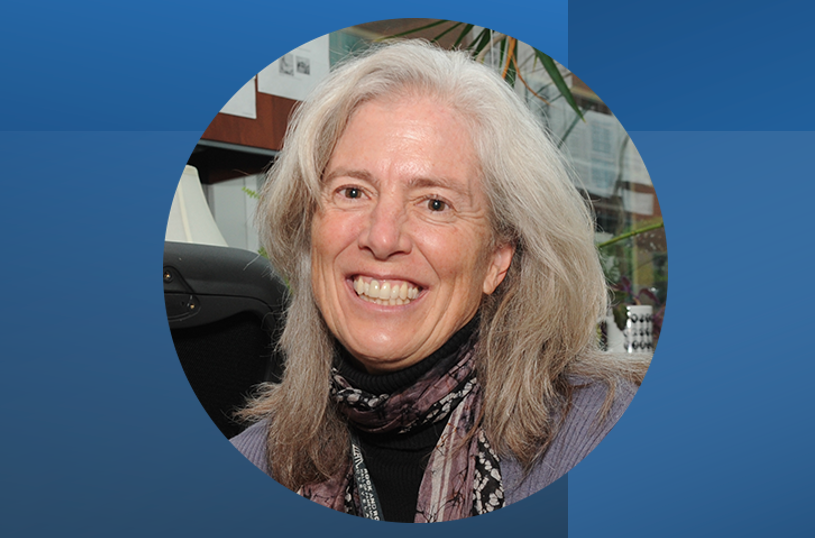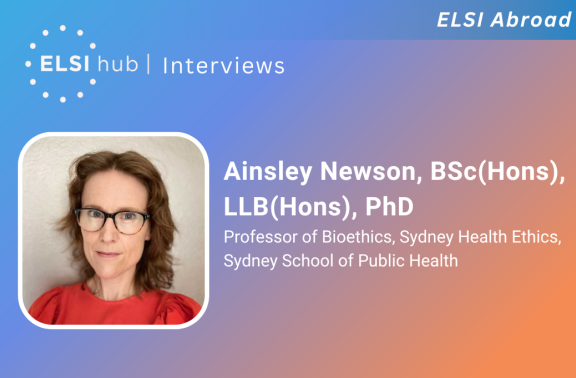
Joy Boyer, Reflections on a Career in ELSI
An exceptional team of program directors administers the ELSI Research Program at the National Human Genome Research Institute (NHGRI), the ongoing, extramural funding program that has served as a primary support to members of the U.S. academic research community in their study of the ethical, legal, and social implications (ELSI) of genetics and genomics for more than thirty years. Working in concert with, but independent from scientific review officers, the ELSI program directors are the key points of contact for the ELSI scientific community in many of their interactions with the institute. They facilitate research opportunities in emerging areas, write funding opportunity announcements, provide advice to applicants and grantees, oversee research progress, and advocate for ELSI research.
ELSI scholars are particularly fortunate to have had expert program directors in their corner. Not least among them has been Joy Boyer, a pioneer who shaped and expanded this innovative area of scientific inquiry for twenty-six years—a stretch which has earned her the title: the longest serving ELSI program director. Joy oversaw a portfolio of research, training, and career development grants; coordinated the Centers of Excellence in ELSI Research (CEER) consortium; and served as the principal contact for the ELSI training grants (T32) program. She championed a robust presence for humanities disciplines in the ELSI grants portfolio and was a thoughtful steward of the archive of ELSI research products. Joy retired from her post in December of 2022 amid a chorus of attestations to her positive impact on the work and career trajectories of many, many ELSI investigators at all stages, including current trainees.
CERA asked Joy to reflect on her work in the ELSI Research Program, how ELSI research topics evolved throughout her tenure, the role of the humanities in the NHGRI ELSI grants portfolio, the optimal relationship between ELSI research and policy, her hopes for the future of the program, and much, much more.
CERA: Do you have a sense of how the focus of ELSI researchers has shifted over the years? What emerging ELSI issues do you see on the horizon?
Joy Boyer: I want to express my gratitude for this opportunity to speak to the ELSI community one more time but need to emphasize that I am now speaking as a private citizen, reflecting on my own experience. My thoughts do not in any way reflect official policy of the National Institutes of Health (NIH) or the NHGRI ELSI Research Program.
When the ELSI Research Program was launched in 1990, the research it funded largely focused on philosophical, legal, and social analyses, with some historical work. The questions were often speculative—not surprising given that the effort to map and sequence the human genome was in its infancy. At that time, research concerned with the potential for misuse of genetic information loomed large in the portfolio. For example, we funded studies concerned with the possibility of genetic stigmatization and discrimination, the potential for unequal access to and use of these new technologies (and the very real likelihood that unequal use would further exacerbate existing social inequities), and existential issues related to the potential for germline manipulation. Funding for these speculative, conceptual, and analytical projects has continued over the years.
As the program grew and clinical uses of genetics became more of a reality, the focus of research funded by the program shifted toward clinical integration. This shift began with the initiation of a request for applications (RFA) for the Cystic Fibrosis (CF) Studies Consortium, which was funded in 1993, followed by the initiation of the Cancer Genetic Studies Consortium in 1994. The work of the CF consortium ultimately led to a 1997 NIH Consensus Development Conference on genetic testing for CF. The Cancer Genetics Studies Consortium produced a series of highly cited, Journal of the American Medical Association articles that provided recommendations for the follow up care of individuals who had tested positive for BRCA mutations, indicating their inheritance of hereditary breast–ovarian cancer syndromes, and hereditary nonpolyposis colorectal cancer (HNPCC) mutations. Around this time, the ELSI Research Program also collaborated with the National Heart, Lung, and Blood Institute and National Institute of Diabetes and Digestive and Kidney Diseases on a large study of hereditary hemochromatosis (HH). This was, in some ways, the first example of an embedded ELSI project. The project supported a large, multi-site clinical study, which resulted in a series of publications on the potential utility of population-based screening for the relevant genetic variants. It also had a broader impact by supporting several legal, ethical, and social analyses that resulted in publications on a range of issues—most notably the potential for genetic discrimination by insurers based on genetic findings indicating the inheritance of HH.
Alongside the launch of the HAPMAP project, the ELSI Research Program issued a series of RFAs in the late 1990s and early 2000s focused on the implications of genetic variation research, particularly for how race and ethnicity were defined and used. These projects formed the basis of the ELSI Genetic Variation Consortium, which resulted in a wide array of publications that serve as the foundation for much of the current ELSI research in this area today. This topic is gaining additional prominence as all of society—and the scientific community in particular—struggles with the legacy of stigmatization, discrimination, and other abuses perpetrated in the name of science.
If I were to identify a particular current issue that I feel is ripe for ELSI research, it would be genetic equity. This is the simple principle that John Harris and John Sulston defined in a 2004 Nature Review article: “… humans are born equal; they are entitled to freedom from discrimination and equality of opportunity to flourish; genetic information may not be used to limit that equality.” Genetic equity and the associated concept of genetic justice are not new ELSI issues. They have been the focus of much research over the 30 years of the program. However, there is a growing openness toward and urgency to consider these issues as well as an increasing sophistication in the scholarship directed toward examining and addressing them—specifically, emerging work in the areas of gender, race, and critical disability studies. This new scholarship will build on early work by scholars such as Mary Mahowald, Troy Duster, Adrienne Asch, and Erik Parens.
CERA: What contributions come to mind when you think about ELSI research from humanities disciplines that was funded by the program over the years?
Joy Boyer: There has been so much excellent ELSI scholarship from the humanities! To me, the humanities really are the foundational discipline of all ELSI research. The humanities are what drew me to the program over twenty-five years ago and support for this research has remained a passion and guiding principle for me as a program director. Bringing rigorous focus to the identification and exploration of the values, norms, and lived experiences of individuals, communities, and society more broadly, provides the foundation on which more empirical studies can be built. In addition, the humanities are critical to the interpretation, dissemination, and use of the data produced by ELSI studies and can help to ensure a more informed, equitable, and just application of genetic information and technologies.
The ELSI program has grown and is now an accepted and valued field of research, but I think sometimes we in the ELSI community take for granted that the NIH would fund this type of research and forget the remarkable and truly historic nature of this commitment, as well as the really hard work that went into establishing the program. I joined ELSI in 1996, a few years after the establishment of the program and just a year or two after the first ELSI Chief, Eric Juengst, moved back to academia. While I wasn’t a witness to those early years, I still marvel at the intellectual effort and sheer, dogged optimism that was required to weather the skepticism of the NIH and the larger research community about this kind of research. It is astounding that Eric and the early ELSI advisory group were able to create, basically from scratch, a new field of NIH-supported biomedical research focused on genetics and built on a blend of the humanities, law, and social and health sciences.
Looking to the future, I expect that the humanities will continue to play a foundational role in the ELSI research portfolio. Specifically, new humanities scholars will be able to build on the foundational work of previous ELSI scholars and bring insights to the important work of ensuring genetic equity and justice.
CERA: In a 2014 paper, you reflected on the ELSI program’s influence and described some ongoing challenges and opportunities. In your opinion, what programmatic challenges persist and what are some important new programmatic opportunities that have arisen?
Joy Boyer: The creation of the ELSI program within the larger Human Genome Project produced a fundamental tension: the ability of ELSI researchers to look critically at the HGP while being administratively housed within the program. This fox-guarding-the chicken-coop conundrum has been a source of friction over the years but has also served as an important guardrail for the program—particularly when ELSI research has been embedded in larger genomic medicine projects. It keeps the issue of the independence of ELSI researchers on the radar screen of both researchers and program administrators and allows for an ongoing consideration of this independence as programs are conceived and implemented. It has helped to keep embedded ELSI researchers from simply becoming human subjects research consultants and has helped ensure that not only are they considered research partners, but that the ELSI research being conducted is both valued and valuable. This is an ongoing challenge.
Truly transdisciplinary research is difficult and requires a constant vigilance and continuous effort to ensure that lines of communication are open and that the strengths of the different research cultures are recognized and honored. Another ongoing, more longitudinal challenge of transdisciplinary research is that, by necessity, it is built on personal relationships. Over time, as research personnel change and more senior researchers retire, the relationships must be renewed, rebuilt, and nurtured. It will continue to be important for the ELSI community to engage in deliberate legacy planning to ensure that these transdisciplinary teams survive and thrive.
CERA: What can you remember about how the T32 ELSI training grants program came about? Do you have a sense that this program is functioning well as a pipeline to research careers in ELSI?
Joy Boyer: In the early years of ELSI research, as the program was establishing itself and beginning to create the necessary multi-disciplinary teams, there was little institutional support for this kind of transdisciplinary research. This was particularly the case in the humanities, law, and social sciences, which are disciplines that required strong, discipline-specific publication records. There also was concern that young researchers needed to firmly establish themselves in their ‘parent’ discipline before becoming deeply involved in a multi-disciplinary research field that was in its infancy.
As ELSI matured and as productive centers of ELSI research were established, it became clear that there was both a recognition of ELSI as an established field and growing institutional support—across all of science—for transdisciplinary research. In addition, the CEERs had established a remarkably strong track record of training young investigators who were then beginning very successful ELSI research careers. These young investigators were notable both for the depth and breadth of their research training and for the diverse range of disciplinary, social, and cultural backgrounds they represented. In addition to the creation of the next generation of researchers, the CEERs had also garnered institutional recognition and support for ELSI research that could provide a foundation for successful institutional training grants.
With all these factors in place, it seemed the time was finally right to establish an institutional training program in ELSI research. The program was small, given the limited ELSI budget, with just three programs receiving funding. While it is a little early to draw definitive conclusions, to date these programs have been very successful at recruiting and training a truly diverse group of ELSI scholars who are now moving on to successful research careers.
CERA: What is/should be the relationship between ELSI research and national health policy? If a connection is desirable, what do you think would make it stronger?
Joy Boyer: ELSI is primarily a research program and should provide a strong foundation on which to build sound health, research, and social policies. More can be done, however, to both disseminate and translate ELSI findings and allow feedback from various policy communities to inform ELSI research.
As in any other field of research, ELSI scholars should be expected to recognize and address the social and policy implications of their research, but they should not be expected to formulate policy. They can, and should, serve as resources for the development of policy, but the bias—or perception of bias—that could be created by direct involvement in policymaking could damage the credibility of their research. This is, of course, a fine line to walk and requires diligence to maintain a reasonable balance. However, it is imperative that the ELSI community retain its independence from the policy-making process and that expectations are not placed on researchers that would compromise this independence.
CERA: What are your hopes for the ELSI field of study?
Joy Boyer: I have been the recipient of a wonderful outpouring of recognition and appreciation for the accomplishments of the ELSI program. While I am truly grateful for this and think the program deserves all the accolades and more, I would like to take just a few minutes to call out the ELSI program officials on whose wide shoulders the program was built. I have already mentioned the pivotal role Eric Juengst played in establishing the program, and would also like to mention Elizabeth Thomson, who almost single-handedly created the ELSI program in genomic medicine (or ‘healthcare’ as she would patiently correct) and nurtured countless early ELSI scholars. Her passion, commonsense, and profound regard for the humanity of researchers and research participants really laid the foundation for the warmth and openness of the ELSI community. In much the same way, Jean McEwen’s clear-headed, intelligent, and balanced leadership was essential in establishing and nurturing ELSI research on the implications of genetic variation and the HAPMAP. This work laid the foundation for much of the current, critically important work focused on similar topics. I really can’t say enough about how much each person brought to the program and the legacy they have left. I feel profoundly fortunate to have had the benefit of their collective vision, wisdom, and patient mentoring as I moved through my own ELSI career.
Moving forward, I feel very confident in the leadership and capabilities of the current ELSI team. Each person brings their own unique passions and strengths, which, when combined with the truly amazing group of established and emerging ELSI investigators, will serve the ELSI program well in the future. My greatest hope is that the field will continue to expand, bringing ever more diverse approaches, perspectives, and voices to the table, without losing sight of the richness of the foundational research that has gone before. I also hope to see deeply thoughtful work in the humanities balanced with the raw power of empirical and translational research. Finally, I hope that the field continues to embrace and grapple with the many tensions inherent in maintaining the independent voice and integrity of this truly unique, transdisciplinary program.
Again, thank you for this opportunity. I can’t express my gratitude for all the warmth and support I’ve received from the ELSI community over the years. I will miss being an active part of the community but look forward to seeing how the program grows and changes in the coming years. It has been a true privilege to work with so many thoughtful and talented researchers. You have mentored, supported, and allowed me to participate in your creative process. Your generosity has made me a better person and allowed me to grow in ways I couldn’t have imagined. This has been a wonderful gift that I will carry with me as I move on to the next phase of my life.



